When the Ministry of the Environment announced on Oct. 9 that subsidies currently offered to Taiwanese who replace petroleum-burning cars or motorcycles with electric vehicles (EVs) would be extended to the end of 2026, some asked if this money would be better spent in other ways.
Between February 2017 and October 2021, commodity-tax exemptions for EV purchases cost the central government NT$5.85 billion. To boost EV infrastructure in less populated areas, the ministry provides an installment subsidy of between NT$200,000 and NT$300,000 for each station outside the six special municipalities. The ministry also offers a subsidy of up to NT$1.6 million per vehicle to buyers of electric buses.
Several local governments also encourage residents to switch to EVs. All electric cars and motorcycles in Taipei are exempt from vehicle license tax until at least the end of next year. On May 15, the Keelung City Government clarified that its electric scooter program will cost around NT$2.75 billion over the next four years.
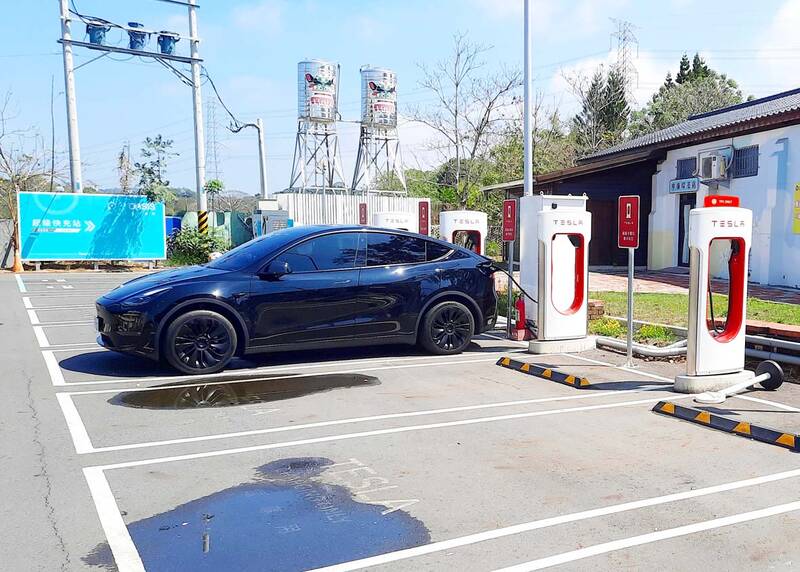
Photo: Steven Crook
EVs are undoubtedly becoming more popular. In 2018, electric cars accounted for just 2.2 percent of new registrations. Of the 36,532 cars delivered to customers last month, 11.6 percent were electric.
But if we’re ever to achieve net zero, we need to get people out of their cars altogether. To that end, the government needs to do a lot more to enhance public transportation systems, encourage cycling and make cities more walkable.
Those who say EVs won’t make much of a difference when it comes to slowing climate change often point out that manufacturing millions of batteries means extracting vast amounts of lithium and other minerals. Furthermore, for the next decade or two, charging those batteries will require burning fossil fuels.
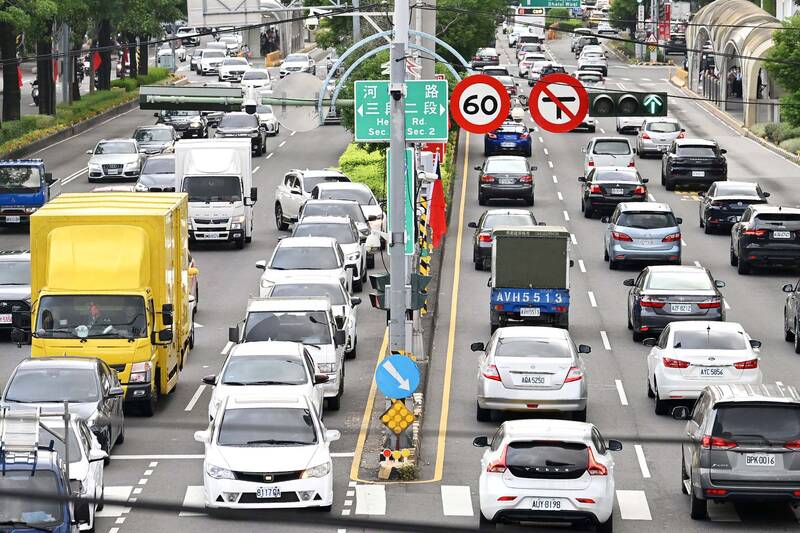
Photo: Liao Yao-tung, Liberty Times
And while it’s true that EVs don’t produce tailpipe emissions, they may actually be worse than vehicles that burn gasoline or diesel when it comes to a different type of environmental damage.
TIRE DUST
Every time a car or motorcycle accelerates, turns or brakes, its tires shed ultrafine particles. The larger and heavier the vehicle, the more such dust it produces. By some calculations, a London bus adds 336g of tire dust to the roadside environment each day — yet so few people are aware of the issue that it’s been called a “stealth pollutant.”
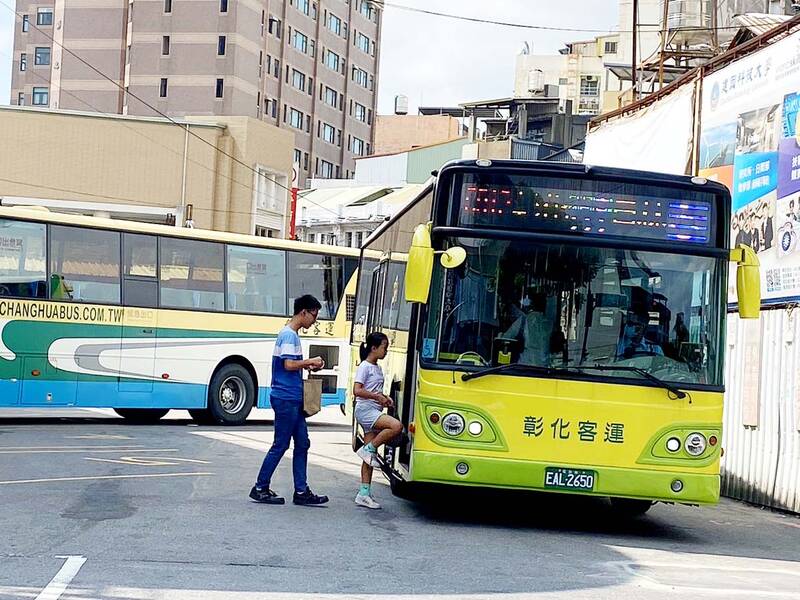
Photo: Chang Tsung-chiu, Taipei Times
According to Breaking the Plastic Wave: A Comprehensive Assessment of Pathways Towards Stopping Ocean Plastic Pollution, a 2020 report compiled by the Pew Charitable Trusts, 78 percent of the microplastic particles that end up in the sea are tire flakes. (In terms of total volume, large items such as plastic bags and bottles are a much bigger problem.)
A recent study by researchers based at the University of Exeter and the University of Plymouth in the UK concluded that plastic microparticles released from common road tires should be treated as a “high concern” pollutant, because they “exert a complex toxic pressure” on living organisms.
To determine the toxicity of such particles and of leachates created by passing water through tire dust, the researchers looked at the effect on water fleas (Daphnia magna). According to a Jan. 29 University of Exeter press release, they discovered that these pollutants “showed a distinct effect on both the reproduction and development” of these small planktonic crustaceans, which also “displayed visible particle uptake within their digestive tract.”
What’s more, rubber particles from tires appeared to be more toxic to water fleas than polyethylene (PE) microplastics.
To ensure the results weren’t influenced by contaminated road surfaces, the researchers used particles taken from pristine tires. Even so, testing detected 54 organic chemicals in all five of the tire brands examined, “with a significant number of those chemicals classified as very toxic.”
The study — published in the Journal of Hazardous Materials — points out that tire-tread fragments from roads “are a major environmental pollutant, with a significant proportion being washed away into waterways near traffic networks. It is estimated that around 18 percent of these particles eventually reach freshwater, while 2 percent reach estuaries.”
It seems that nobody in Taiwan has studied the issue of tire dust. However, research by a team from National Taiwan University and National Yang Ming Chiao Tung University suggests there’s another pollutant that should inspire efforts to reduce the amount of traffic on local roads.
On Oct. 13, 2022, the Chinese-language United Daily News reported that the team had measured and analyzed suspended particles along Taipei’s Keelung Road (基隆路). In addition to exhaust emissions, they detected metal particles which they theorized were in the air as a result of brake pads rubbing against brake discs each time a road user had to slow down.
Expressing concern that high concentrations of metal particles could be harmful to humans, the lead researcher told the newspaper that the exact composition of polluted air along major roads deserves further investigation.
HEAVYWEIGHT VEHICLES
The heftier the vehicle, the greater the tire abrasion — and EVs weigh a good bit more than their gasoline-powered counterparts.
Including batteries, a Gogoro scooter is approximately 12 percent heavier than a 125cc Kymco two-wheeler with a full tank of gas.
On April 8 last year, British newspaper The Telegraph warned that multistory parking facilities “could be at risk of collapse as heavier electric vehicles put pressure on aging infrastructure.”
As vehicles get heavier, road surfaces break up more quickly. In late 2022, the US city of Indianapolis began ripping up and redoing stretches of pavement laid less than three years previously. The city’s public transit agency said that the weight of 18m-long electric buses running the same routes all day every day had caused much more wear and tear than expected.
Electric-vehicle cheerleaders say the next generation of EVs will be lighter, because technological advances are gradually improving the energy density of batteries. Yet buyers might prefer being able to go further on a single charge to owning a car that weighs a bit less.
In the case of electric city buses, there’s an obvious way to cut weight and thus reduce road wear and tire abrasion: Instead of deploying vehicles that carry batteries, Taiwan’s urban areas could emulate Athens, Milan and other cities, and set up trolley-bus networks. Trolley-bus infrastructure is far cheaper to build than metro lines or light rail systems. And because they don’t need to haul batteries and are thus lighter, trolley buses use less energy than electric buses per passenger kilometer. But they still generate tire dust.
Scientists say it may be possible to adjust tire chemistry so as to reduce toxicity. In the meantime, innovators are trying to perfect technology that can capture rubber fragments before they’re blown to the four winds.
The London-based Tyre Collective has been trialing a device that collects ultrafine particles by attracting them to electrostatically charged copper plates. According to their Web site, the particulates they capture “can be upcycled into industrial and consumer applications such as bitumen, shoe soles and soundproofing.”
There’s another way to reduce tire dust and brake metal particulate pollution from vehicles, as well as carbon emissions.
Stipulating that each household can use their car for up to 5,000km per year, but that every additional kilometer will incur a special tax, would encourage people to explore alternative forms of transportation. Each year, the threshold could be lowered. Back in 2008, the government did something similar with the electricity tariff, hiking the price while telling families that, if they consumed less power than in the previous year, they’d be charged the old per-kWh rate.
If such a scheme is to be politically acceptable, there’ll need to be concessions to those living in remote areas. It’s quite possible, however, that few voters would argue that residents of Nantou County’s mountainous Sinyi Township (信義) deserve a much more generous tax-free driving allowance than people living in central Taipei.
Steven Crook, the author or co-author of four books about Taiwan, has been following environmental issues since he arrived in the country in 1991. He drives a hybrid and carries his own chopsticks. The views expressed here are his own.
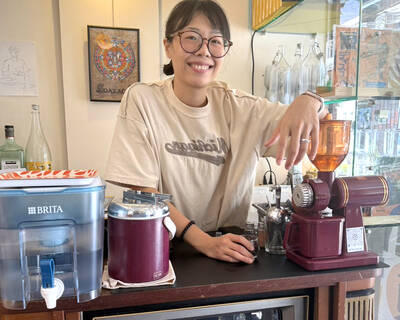
Cheng Ching-hsiang (鄭青祥) turned a small triangle of concrete jammed between two old shops into a cool little bar called 9dimension. In front of the shop, a steampunk-like structure was welded by himself to serve as a booth where he prepares cocktails. “Yancheng used to be just old people,” he says, “but now young people are coming and creating the New Yancheng.” Around the corner, Yu Hsiu-jao (饒毓琇), opened Tiny Cafe. True to its name, it is the size of a cupboard and serves cold-brewed coffee. “Small shops are so special and have personality,” she says, “people come to Yancheng to find such treasures.” She
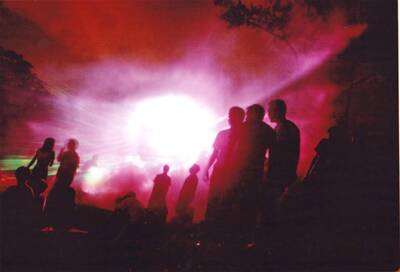
In July of 1995, a group of local DJs began posting an event flyer around Taipei. It was cheaply photocopied and nearly all in English, with a hand-drawn map on the back and, on the front, a big red hand print alongside one prominent line of text, “Finally… THE PARTY.” The map led to a remote floodplain in Taipei County (now New Taipei City) just across the Tamsui River from Taipei. The organizers got permission from no one. They just drove up in a blue Taiwanese pickup truck, set up a generator, two speakers, two turntables and a mixer. They
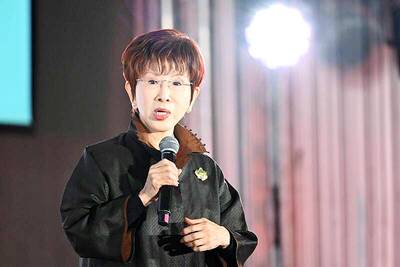
Former Chinese Nationalist Party (KMT) chairwoman Hung Hsiu-chu’s (洪秀柱) attendance at the Chinese Communist Party’s (CPP) “Chinese People’s War of Resistance Against Japanese Aggression and the World Anti-Fascist War” parade in Beijing is infuriating, embarrassing and insulting to nearly everyone in Taiwan, and Taiwan’s friends and allies. She is also ripping off bandages and pouring salt into old wounds. In the process she managed to tie both the KMT and the Democratic Progressive Party (DPP) into uncomfortable knots. The KMT continues to honor their heroic fighters, who defended China against the invading Japanese Empire, which inflicted unimaginable horrors on the
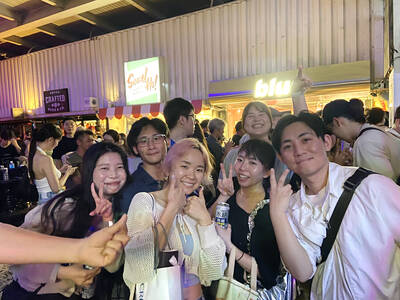
Hannah Liao (廖宸萱) recalls the harassment she experienced on dating apps, an experience that left her frightened and disgusted. “I’ve tried some voice-based dating apps,” the 30-year-old says. “Right away, some guys would say things like, ‘Wanna talk dirty?’ or ‘Wanna suck my d**k?’” she says. Liao’s story is not unique. Ministry of Health and Welfare statistics show a more than 50 percent rise in sexual assault cases related to online encounters over the past five years. In 2023 alone, women comprised 7,698 of the 9,413 reported victims. Faced with a dating landscape that can feel more predatory than promising, many in